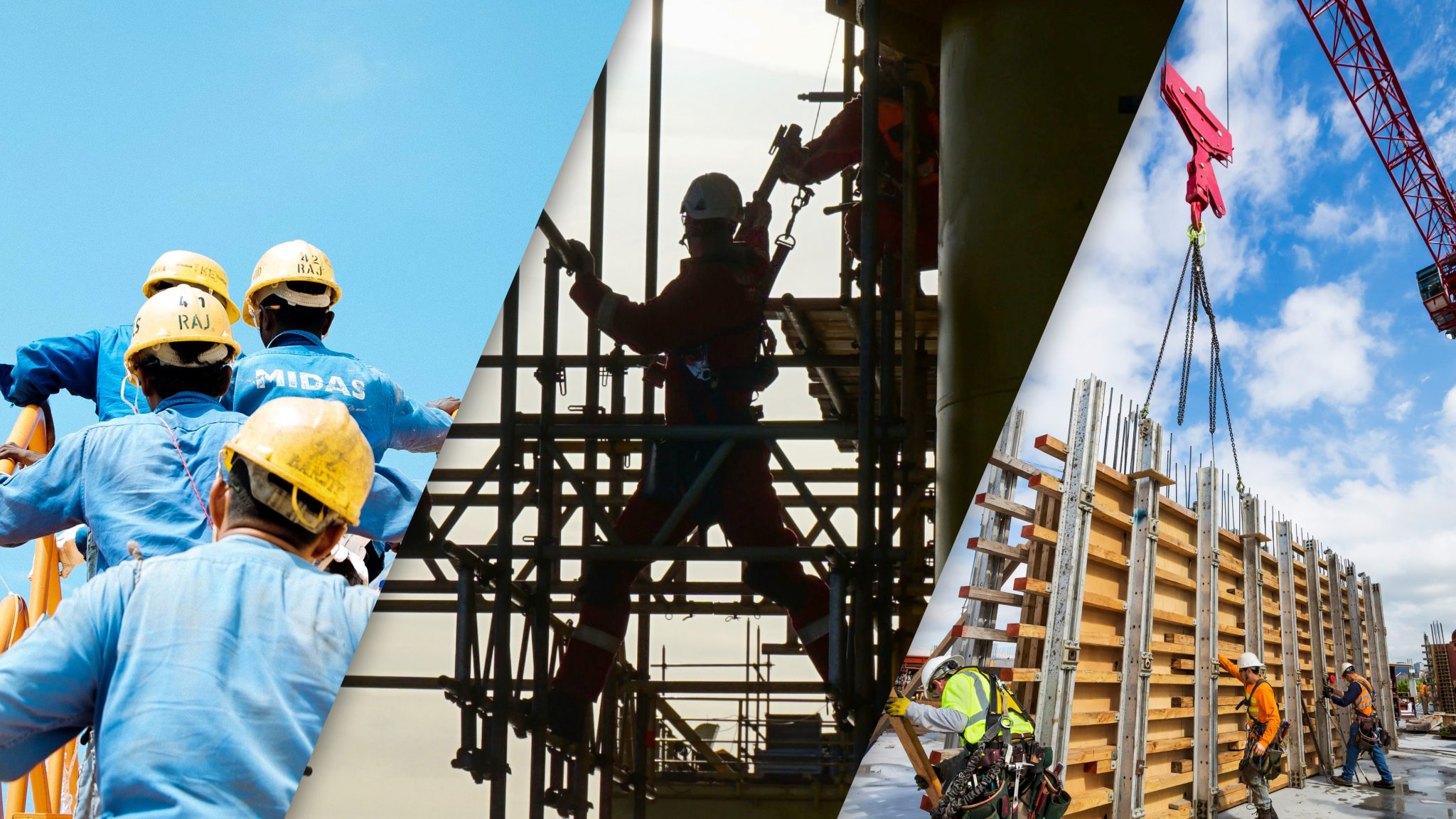
This article was co-written by Olivier Lepinoy, Senior Global Business Development Executive – Platform Subject Matter Expert, Autodesk & Giso van der Heide, Senior Customer Outcome Executive EMEA, AEC Strategic Accounts, Autodesk.
The future of construction is already here. To build resiliency and future proof their businesses, leading AEC firms take their destiny into their hands. They play offense, collect data, build their own digital platforms, operate them with new business models, and offer new services to their ecosystem.
At Autodesk, we have had the honor to work for some of the most innovative AEC companies in Europe including Acciona, Arcadis, Bouygues Construction, Ferrovial, LafargeHolcim, NCC, Royal BAM, and VINCI Construction. These firms are embracing the future of construction and changing the rules of the game. We wrote this article as a reflection from our discussions with key stakeholders from these companies on how the AEC industry is transforming.
A lot of changes are happening around us: technology is now available at low cost; disruption is everywhere, and digital transformation has replaced digitization. In all industries, and in the public sphere as well, traditional delivery models are challenged by digital. Countless examples show that the risk of commoditization and productization is greater than ever, even for the incumbent players. To minimize this risk, some companies and organizations decide to progressively let go of the way things are done, to change their mindsets and ordinary perceptions. They start a journey towards total transformation and self-disruption. For them, the adoption of new technologies is not an end; it is a necessary catalyst for change. The final destination is the reinvention of their business.
In the AEC industry, the value chain, project delivery networks and ecosystems are still very sequential, fragmented, and transactional. Most, if not all companies are paralyzed by the same status quo: low productivity, low predictability, low margins, adversarial pricing models, financial fragility, lack of collaboration, lack of investment in R&D and innovation, poor image and attractiveness. Meanwhile, clients are increasingly concerned that the sector is not keeping pace with the rates of improvement seen in other sectors. Society at large is increasingly concerned that the sector is not able to meet the imminent challenges posed by climate change, urbanization, and social expectations. “At a time when sustainability is more urgent, the playfield become more complex: the traditional supply chain is disrupted by new players, and every company needs to rethink its position,” says Christina Claeson-Jonsson, Global Head of Research & Innovation at NCC.
Innovation through technology (the typical way to foster innovation) is not enough anymore. It has become obvious that technology alone will not provide the needed solutions and that new mindsets are imperative. As history has shown us, true and sustainable innovation does not solely come from technology, it comes from new partnerships, new organizations, new behaviors, and new business models.
The construction industry is at a tipping point. “Construction is finally evolving, everyone now wants to capture the value of digital,” says Rafael Fernandez Garcia, Global Director of Innovation at Ferrovial. “The movement cannot be stopped, and speed of execution is now essential.” With growing damage to the environment, the industry needs to truly reset its fundamentals. Beliefs and orthodoxies must be challenged to leave room for more radical transformations. This is a necessary step for a long-lasting change to happen. “The current model has been pushed to its limits and it is now out of breath,” says Frédéric Gal, Director of Bouygues Construction Digital Project Management Platform. “More ambitious environmental targets will put the system down and an alternative model is needed.”
The ongoing revolution is an invisible one. On the surface, things look unchanged. The most essential changes occur in the way the industry is structured and how companies behave, not in the way buildings or infrastructures are constructed. Across the globe, design offices and construction sites look similar compared to ten years ago. But the technology used, the types of companies involved, the types of contacts and transactions between parties, the underlying business models are radically different.
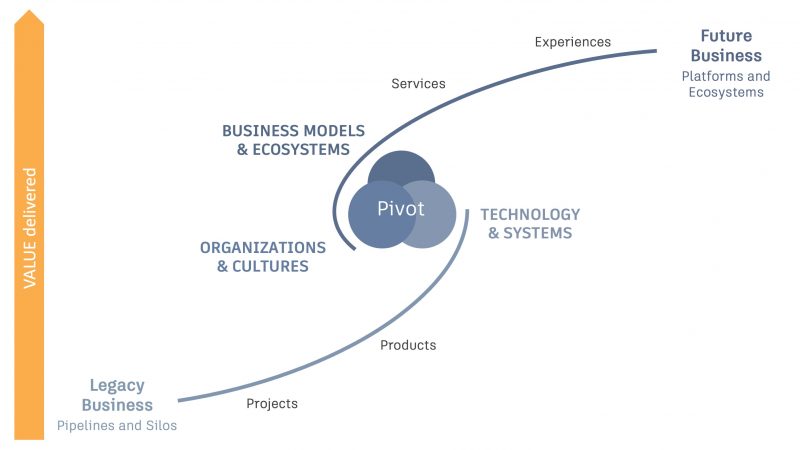
What is this invisible revolution made of?
The boom of integrated software platforms in construction has been well explained by McKinsey in “Rise of the platform era: The next chapter in construction technology.” Platforms are now part of the landscape and take an essential role in how value is created and delivered. What is new is the emergence of platforms created and managed by the AEC players themselves. Indeed, the most innovative AEC companies already launched their own strategic initiative around platforms and are trying to create new ecosystems around them. They have understood that they are orchestrators of large networks of resources already, but they want more. Moving to the next level implies new contracting mechanisms, a change in skill sets, new processes and standards, and new types of partnerships and alliances.
As we explained at Autodesk University 2020 (“New Business Models and Digital Platforms in Construction 4.0”), the ambition of leading AEC companies is to make a step change. To do so, they partner with technology companies, build tailor-made solutions, develop new service offerings, and conceive new business models to deliver and capture value. They try to move up the ladder, from asset designers and builders, to service providers, to technology creators and ultimately to network orchestrators.
Companies like Grupo ACS, Bechtel, Bouygues, Daiwa House, Ferrovial, Kajima, Larsen & Toubro, Lendlease, Royal BAM, Takenaka, and VINCI have all launched strategic initiatives in this direction. Some of these large players already manage several business models. In this case, the challenge is to diversify even more and to build synergies between the old and the new. For other large companies, adjacent to the AEC industry, the pivot of their business and their transformation is already underway. Caterpillar, ISS, Jones Lang LaSalle, Kone, LafargeHolcim, Saint-Gobain, Schneider Electric, and Wienerberger are examples here. Across the globe, mid-size and large engineering firms (AECOM, Arcadis, Fluor, Jacobs, WSP) are also attempting to pivot and grow differently. The largest and most innovative design and architectural firms also try to reinvent themselves: offer new services and use digital to grow.
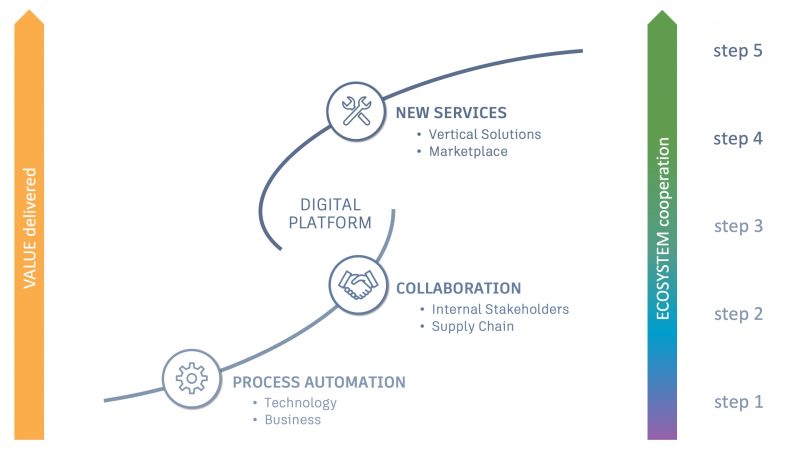
Companies try to differentiate themselves through platforms because platform is considered by all technology and business experts as the most profitable type of business model. But it is still difficult to predict what is going to happen. Are we going to see the emergence of a multitude of digital platforms and later a competition between them? How many of these initiatives will be successful, grow, and last? Business models scale differently, and network orchestrators grow revenues faster, generate higher profit margins, and use assets more efficiently than companies using traditional business models. For incumbent firms, it is a journey and not an easy one. As Matthé van Baalen, Global Director of Design & Engineering at Arcadis puts it, “We observe an incredible acceleration of digital transformation. Business as usual does not exist anymore. We are fully aware of the cultural shift required to make a step change. Incorporating digital technology in our daily work is one thing, but we also invest massively in our mind shift.” Pascal Berger, CEO of Sixense (subsidiary of VINCI Construction) says “Even if the short-term ROI is not obvious, ambitious moves need to be trigged now to plant seeds for the future.”
During this long transition toward more platforms, roles and boundaries are changing and becoming blurry. What is certain is data will be at the center of everything. It already is. All AEC firms currently create and consume data. “What matters most is which party provides which operational data to inform the rest of the value chain,” says Philipp Leutiger, Global Chief Digital Officer at LafargeHolcim. “If companies were all more open to share their business challenges and their operational data, we would make a lot of progress. The data that I have can solve your problem, we should talk.” What will likely happen later is a dramatic ecosystem shift and the emergence of new types of players. “Disruption will happen sooner than later, and we would rather be the disruptor than the disrupted,” says Frédéric Gal from Bouygues Construction. A key success factor in this journey is the maturity of your ecosystem and how you manage these external resources.
Digitization is implementing technology. On the contrary, digital transformation is not simply acquiring and injecting technologies into the organization and waiting for magic to happen. Technology in itself has no single objective value. What matters is what you accomplish with it. How do we design and execute a digital transformation?
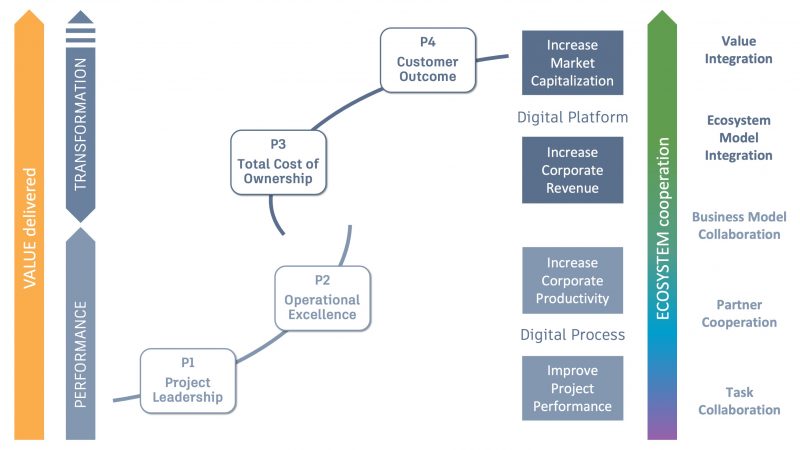
The progress and maturity of a digital transformation can be characterized by four “plateaus” (P1, P2, P3 and P4). Moving up to a higher plateau implicates more value realization and driving purposeful business. Oftentimes it begins with the current model and it focuses on improving the project execution and its margins (P1 = Project Leadership = standardized and repetitive). The following step is to achieve better operational results (P2= Operational Excellence = integrated, optimized and automated). Both plateaus are intended to make “smaller” tweaks at the existing operating model. The efforts are placed in the optimization of processes and the creation of pure digital ones.
Thereafter comes an important turning point. With P3 and P4, you initiate more impactful shifts in the business model and aim to become more data-driven and customer-centric. Most of the time, you need to have a digital platform to reach plateaus P3 and P4. You can either use one, share one, or build your own. As Telmo Pérez Luaces, Global Chief of Innovation and New Business at Acciona puts it, “the aspiration for new business models and platforms is strong but, unfortunately, initiatives across the industry are rare.” Implications are also at the level of the ecosystem, from task collaboration and partner cooperation, to the management of a decentralized, autonomous ecosystem. What matters then is how you orchestrate resources within a network. The focus is on the value delivered by the ecosystem. Value creation happens then more horizontally than vertically, when open innovation and co-creation are the norm. If they reach this level of maturity, companies can focus on their corporate purpose, instead of struggling with their daily operations.
In today’s environment, AEC firms want to be more intentional about their digital transformation. They need a safe environment to define their strategy for their future. The “Arc of Transformation” program has been created by Autodesk to help them prepare and develop their out-of-the-ordinary initiatives with new mindsets and behaviours. We have defined frameworks and interactive activities which act as catalysts for these transformations. Yet, the approach is always tailor-made. Each company can create its own recipe with the ingredients we offer. Each business outcome is specific to each company and there are multiple ways to achieve a defined outcome. The only objective is to create the best conditions to catalyze new types of transformation.
During these sessions, everything can be questioned: objectives, expected benefits, strategy, tactic, implementation, management of change, collaboration, engagement model, governance, executive sponsorship, direct and short-term value delivered, indirect and long-term value creation, maturity of the ecosystem, required alliances, etc. We define together how value can be delivered through technologies such as Connected BIM, Reality Capture, 3D Printing, Robotics, Virtual Reality, Artificial Intelligence, Digital Twin, IoT, Blockchain…
These sessions are an opportunity to reset the relationship and to redefine what supplier, client, technology provider, and business partner really mean. When we do this, we apply the principles of “consultative selling” and make them a reality. We prioritize open dialogue to identify and provide solutions to customers' needs. The focus is on the customer, rather than the product being sold.
The “Arc of Transformation” offers a space for a dialogue between Autodesk and its customers.
This simple sequence offers a controlled environment to test new ideas and to learn from the open dialogue.
In order to go beyond heroics, a focus is placed on the cultural aspect of transformation. We believe this is one of the missing pieces of the puzzle. A lot of customer initiatives fail because this domain is underestimated. “Change will not happen without the people. Employees of construction firms are willing to change but we need to clearly explain why,” says Christina Claeson-Jonsson from NCC. This is why we use a lot of interactive exercises during these sessions. While working with firms, we observe how our clients perceive themselves. Together, we build a plan that embraces Plateau 1, 2, 3 and 4. The objective is to offer frameworks to kickstart the business transformation, to set the right priorities, to establish a solid program, and to quickly achieve tangible outcomes. “One of the greatest risks we face is to under-deliver on our promises and to create disappointment,” says Pascal Berger from VINCI Construction. “After being very strategic, we need to be very pragmatic and down-to-earth”.
A key aspect in this journey are business model transformation and sustainability. To make sure we are well connected with our customers’ corporate goal and Sustainability Development Goals (SDG), we use the AEC Business Model Playbook. It contains industry best practices to navigate digital transformation. It offers various perspective and possibilities:
To maximize the value delivered, the “Arc of Transformation” embraces the whole customer journey, from vision to implementation. Our customers already started their digital transformation journey. The question for them is not if they would start this adventure, but how. A partnership with a technology company like Autodesk needs to be considered as a possibility. But a partnership is only a mean to an end. The overarching objective is the transformation of the company, its constant adaptation to rapidly changing situations.
What kind of value can we deliver during such a journey? Let’s take the “B2B Elements of Value” identified by management consulting firm Bain to clarify this. Out of the 40 discrete “value elements” three value categories emerge: Inspire Change, Formulate Strategies, and Develop Business Value, each with specific value elements attached.
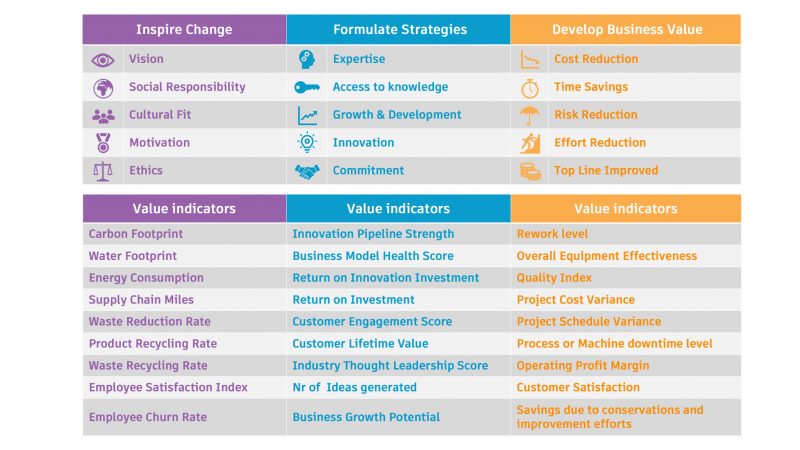
What is the correspondence between these value indicators and the customer journey? The graph below shows an example of a customer journey; it contains ten major touchpoints and the fifteen value elements plotted along.
With touchpoints 1 and 2, the customer and Autodesk are literally onboarding each other. Who are we? What drives us? Do we have similarities in our vision, mission, and strategy? We brainstorm on motivations, purpose, and how to build further a relationship of trust. The major value elements are: Vision, Social Responsibility, Cultural Fit, and Motivation. This stage is also used to trigger out-of-the-ordinary thinking on digital transformation, platforms, business models and culture. As Telmo Pérez Luaces from Acciona puts it, “More than Technology R&D, we want to have a holistic approach. We want to see new types of innovation and understand new business models.” The “Arc of Transformation” creates the conditions for a good mutual understanding and for the customer to reflect on its strategic aspirations.
During this formulation period, the customer and Autodesk can share their Expertise and Knowledge, and work at identifying potential Growth & Development areas for the customer. Touchpoints 3 to 5 are supported by diverse exercises related to scenario planning, business models, and technology innovation. “Scenario planning is essential to make sure we are not missing any blind spot,” says Menno de Jonge, Global Director of Digital Construction at Royal BAM. “Our goal is to progress from ‘Doing Things Better’ to ‘Doing Better Things’ to ‘Doing New Things.'” To make new things possible, new partnerships and alliances are discussed on point 6.
This important stage translates the customer’s vision and strategy into prioritized business initiatives. A focus is put on means to build the right internal and external capabilities to achieve the targeted outcomes. “Integrating and building new capabilities is, for the incumbents, essential,” says Rafael Fernandez Garcia from Ferrovial. Cost Reduction, Time Savings, and Risk Reduction are also given the highest priority. Touchpoints 7 to 9 focus on building solid roadmaps to address the following needs: Capability Building, Measurable Outcomes, and Change Management. Later (point 10 and after) comes the Agile Implementation of New Workflows and the Deployment of Technology.
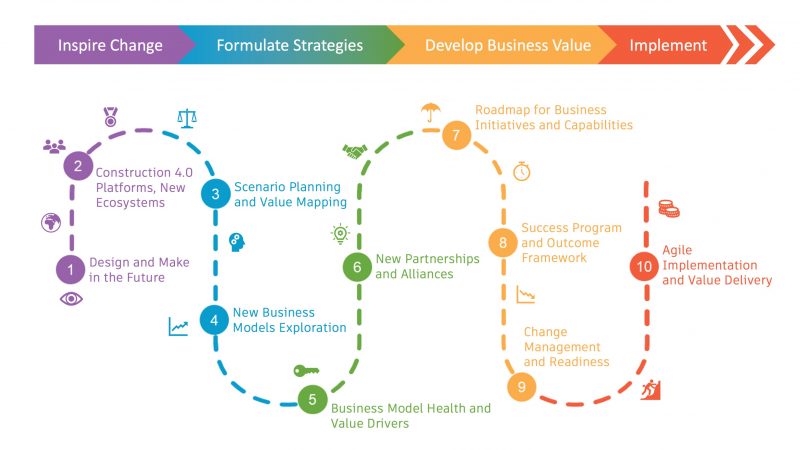
More frugal, agile and connected, let’s take a quick look at what the future of AEC could look like. Manual workers, robots, equipment and machines, raw material, and building products will still be necessary to construct, but they will become commodities. Data will be a new raw material. Firms and organizations will buy, sell, and trade data. There will be data miners, data controllers, data brokers, data wholesalers, etc. Later we will see the emergence of new types of players and ecosystems: the Originators, the Aggregators, the Providers, the Controllers, the Consumers.
In this unclear future where boundaries we know have become more ambiguous, a key question will be: who will become the main information contractor? “In an environment dominated by platforms, the players will ask themselves: who will be the providers of the platforms, who will the producers of the offerings, of the data, of the services, who will the consumers of the services, who will be the owners of these platforms, and who will control the Intellectual Property?” says Menno de Jonge from Royal BAM. All companies in the AEC industry need to decide. Do they want to develop technology tools to support productivity and deliver value to their direct clients? Do they want to become a technology integrator and develop platforms for others to develop their own solutions? Do they want to become a hub to connect, aggregate, and deliver value to the whole ecosystem along the whole lifecycle of built assets?
We strongly believe that we are talking about a future which is already here. What are the most visible signs of this invisible revolution? All companies are asking themselves:
As Peter Thiel writes in the first sentence in the preface of his book Zero to One: ”Every moment in business happens only once.” We strongly believe that, for the AEC industry, this defining moment is now. The tipping point has been achieved: reverting to “business as usual” is no longer an option.
We want to thank the following for their contributions to this article:
We will present this work in more detail during a virtual session at Autodesk University 2021. It can be found in the Industry Talk section. It is called “Construction 4.0: Customer Journey toward Total Business Transformation” (#CS500010). We encourage you to vote for it if you want this session to be featured at the conference: https://autode.sk/3sUXYUg

May we collect and use your data?
Learn more about the Third Party Services we use and our Privacy Statement.May we collect and use your data to tailor your experience?
Explore the benefits of a customized experience by managing your privacy settings for this site or visit our Privacy Statement to learn more about your options.